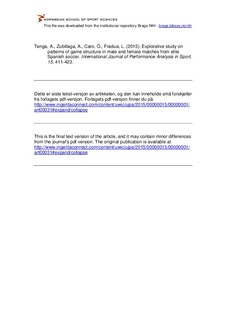| dc.contributor.author | Tenga, Albin | |
| dc.contributor.author | Zubillaga, Asier | |
| dc.contributor.author | Caro, Óscar | |
| dc.contributor.author | Fradua, Luis | |
| dc.date.accessioned | 2016-10-06T09:12:08Z | |
| dc.date.available | 2016-10-06T09:12:08Z | |
| dc.date.issued | 2015-03 | |
| dc.identifier.citation | International Journal of Performance Analysis in Sport. 2015,15, 411-423. | nb_NO |
| dc.identifier.uri | http://hdl.handle.net/11250/2413183 | |
| dc.description | I Brage finner du siste tekst-versjon av artikkelen, og den kan inneholde ubetydelige forskjeller fra forlagets pdf-versjon. Forlagets pdf-versjon finner du på www.ingentaconnect.com / In Brage you'll find the final text version of the article, and it may contain insignificant differences from the journal's pdf version. The definitive version is available at www.ingentaconnect.com | nb_NO |
| dc.description.abstract | The aim of this study was to explore emergent patterns of game structure in male and female matches from elite soccer by using playing distances measured according to the ball location. Archive data based on carefully selected four male and four female matches from elite Spanish soccer seasons 2002-3, 2003-4 and 2004-5 were collected by help of AMISCO PRO® system. Differences across six ball locations were found in mean playing length (χ2 5=328.1 and 520.9, P<0.001) and playing width (χ2 5=39.6 and 26.9, P<0.001) from male and female matches, respectively. Both sexes displayed similar movements in playing length that vary with stretch-contraction-stretch patterns and in playing width that vary with opposite patterns of contraction-stretch-contraction, but these patterns varied to a significantly greater extent in male matches. For example, male matches (mean=44.93±8.34 m) produced significantly (U=128564.0, z=-8.2, P<0.001) longer playing width during transition phase in midfield compared with female matches (mean=41.80±8.00 m). Results suggest that female matches produced less favourable patterns of game structure with fewer penetration opportunities than male matches. Specific suggestions for coaching intervention were given. This study demonstrates the potential of analysing playing distances according to the ball location for studying patterns of game structure in real soccer matches. | nb_NO |
| dc.language.iso | eng | nb_NO |
| dc.publisher | Cardiff Metropolitan University | nb_NO |
| dc.subject | game structure | nb_NO |
| dc.subject | match performance analysis | nb_NO |
| dc.subject | movement behaviour | nb_NO |
| dc.subject | sex differences | nb_NO |
| dc.subject | soccer | nb_NO |
| dc.title | Explorative study on patterns of same structure in male and female matches from elite spanish soccer | nb_NO |
| dc.type | Journal article | nb_NO |
| dc.type | Peer reviewed | nb_NO |
| dc.subject.nsi | VDP::Social science: 200 | nb_NO |
| dc.subject.nsi | VDP::Social science: 200::Social science in sports: 330 | nb_NO |
| dc.source.journal | International Journal of Performance Analysis in Sport | nb_NO |
| dc.description.localcode | Seksjon for coaching og psykologi / Department of Coaching and Psychology | nb_NO |
